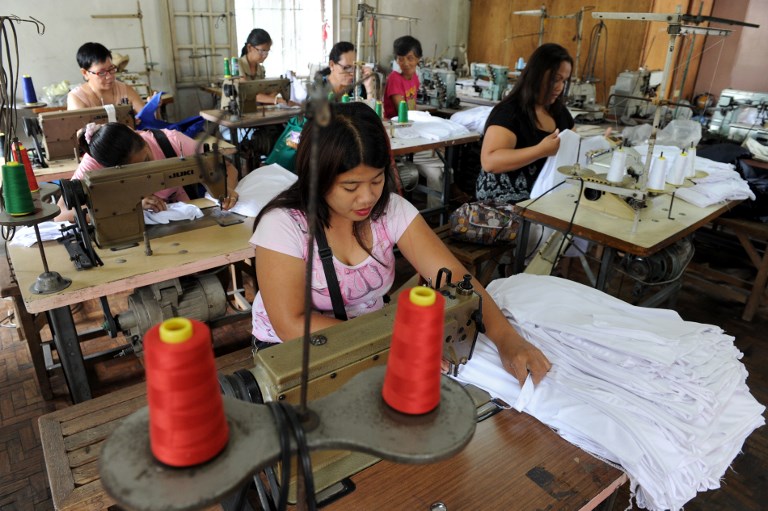IHS Markit: PH manufacturing growth further slowed in April

Women work at a sweatshop sewing clothes under contract with local clothing manufacturers in Manila on July 12, 2013. The latest Nikkei Philippines Manufacturing Purchasing Managers’ Index released Thursday showed that the seasonally adjusted PMI dropped to 50.9 last month from 51.5 in March. AFP FILE PHOTO / Jay DIRECTO / AFP PHOTO / JAY DIRECTO
MANILA, Philippines — Manufacturing growth in April further fell to its slowest pace in 19 months as export orders declined even as traders already found some relief from port congestion in Manila.
The latest Nikkei Philippines Manufacturing Purchasing Managers’ Index released Thursday showed that the seasonally adjusted PMI dropped to 50.9 last month from 51.5 in March.
Since the April PMI score remained above 50, it meant that there was an overall increase in manufacturing activity.
However, the April PMI figure was the lowest since September 2017’s 50.8.
The April PMI “signalled only a slight improvement to business conditions, one that was softer than seen throughout the first quarter of the year,” IHS Markit, which compiles the PMI survey data, said in a report.
IHS Markit blamed the weak increase in production levels last month to a “moderate decline” in overseas demand for Philippine-made goods.
Also, new orders grew at the softest pace in nine months or since July last year, IHS Markit added.
According to IHS Markit, “Firms responded by reducing job numbers for the second month running, while also lowering stocks of pre-production goods. Output prices increased only modestly, as fewer manufacturers reported higher input costs. Optimism surrounding future output improved, but remained subdued on average.”
“April PMI revealed an even more subdued picture for the Philippines. With first quarter results already reflecting weaker manufacturing growth than at the end of last year, the latest data did little to raise hopes for the second quarter. Output expanded at the weakest rate since September 2017, while new order growth was dampened by a quicker drop in export sales,” IHS Markit economist David Owen said in a statement.
Owen nonetheless said “there was some positive news from the survey as firms reported an alleviation of import delays due to the recent port congestion at Manila.”
Last month, the Bureau of Customs (BOC) claimed that yard utilization at the Manila International Container Port (MICP) and Port of Manila (POM) had already been “significantly reduced” as the country’s second biggest revenue agency moved to address high utilization.
For one, BOC had temporarily prohibited returning empty containers at MICP and POM, as it had blamed high yard utilization to overstaying imports stored within the premises of these two ports, unreturned empty containers, and the truck ban being implemented in Manila.
As such, “as of April, the yard utilization level was down to 69 percent from 95 percent in January at POM. Meanwhile, the utilization rate at MICP is at 70 percent from 90 percent at the beginning of the year,” BOC had said.
For Owen, easing port congestion “led to the first improvement in supplier delivery times in nine months, although slowing output growth still led manufacturers to reduce stock levels.”
“With the national election during May, production growth may be stifled again in the next survey. As such, it is looking like the second quarter may prove to be a challenging one for the manufacturing sector,” according to Owen.